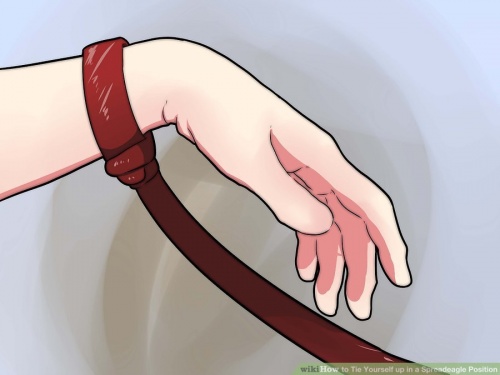Tie Yourself up in a Spreadeagle Position
Tying yourself up in this position can be a hard thing, but if you know the way, it gets pretty easy. Always remember to plan how you will get out of it BEFORE tying yourself up, or you might stay there for good. this article is about getting into a spread-eagle tie, not getting out.
Steps
- Tie the ropes/lock the chains/cuffs to the four posts. If you're using the variant with three chains and one rope, position the rope where your main hand will be.
- Tie your legs to the two lower posts as tight as you want them. Don't use a slipknot, as it might get really tight as you struggle, which might stop your blood flow. Remember that if you spread your legs too much it might get very uncomfortable over time.
- Tie a slipknot on the rope that will hold your main hand, but don't put the hand in yet.
- Tie your other hand to the corresponding post.
- Get your last hand into the slipknot and pull it tight. If you position the knot itself behind your palm, it will be nearly impossible to escape by yourself. Of course, a handcuff is easier to use but not everyone has one.
Tips
- You can go with no release method, and simply tell someone to drop by in a couple of hours. Be aware of the risks though, for example what will you do if a fire breaks out or what happens if you start losing circulation?
- You can add a gag, blindfold, spreader bar (for the knees), toe tie, or anything you want.
Warnings
- Make sure that the supervisor is trustworthy. In a vulnerable position like this, he/she can tickle you like crazy!
- Tying yourself up is always risky, and should preferably be done under supervision. Make sure you can get out, and always have an extra release method.
Things You'll Need
- A four post bed, or just any four objects at appropriate distances from each other that won't move if you pull them.
- Four approximately one meter long ropes. Cotton ropes are the best, but anything that doesn't hurt your skin too much over time can do. Three of the ropes can be replaced by padlocks and chains of the same lengths, but it it is recommended that you use at least one rope, it's simply easier that way. Or, all of these can be replaced by hand- and ankle cuffs, but be advised that these may start hurting if you keep them on too long/too tight.
- A way to get out. This may be done any way you want, depending on what you use to restrain yourself, some options are having a knife/scissors within reach if you use rope, or if you use chains and padlocks, having the key in an ice cube hanging from the ceiling.
